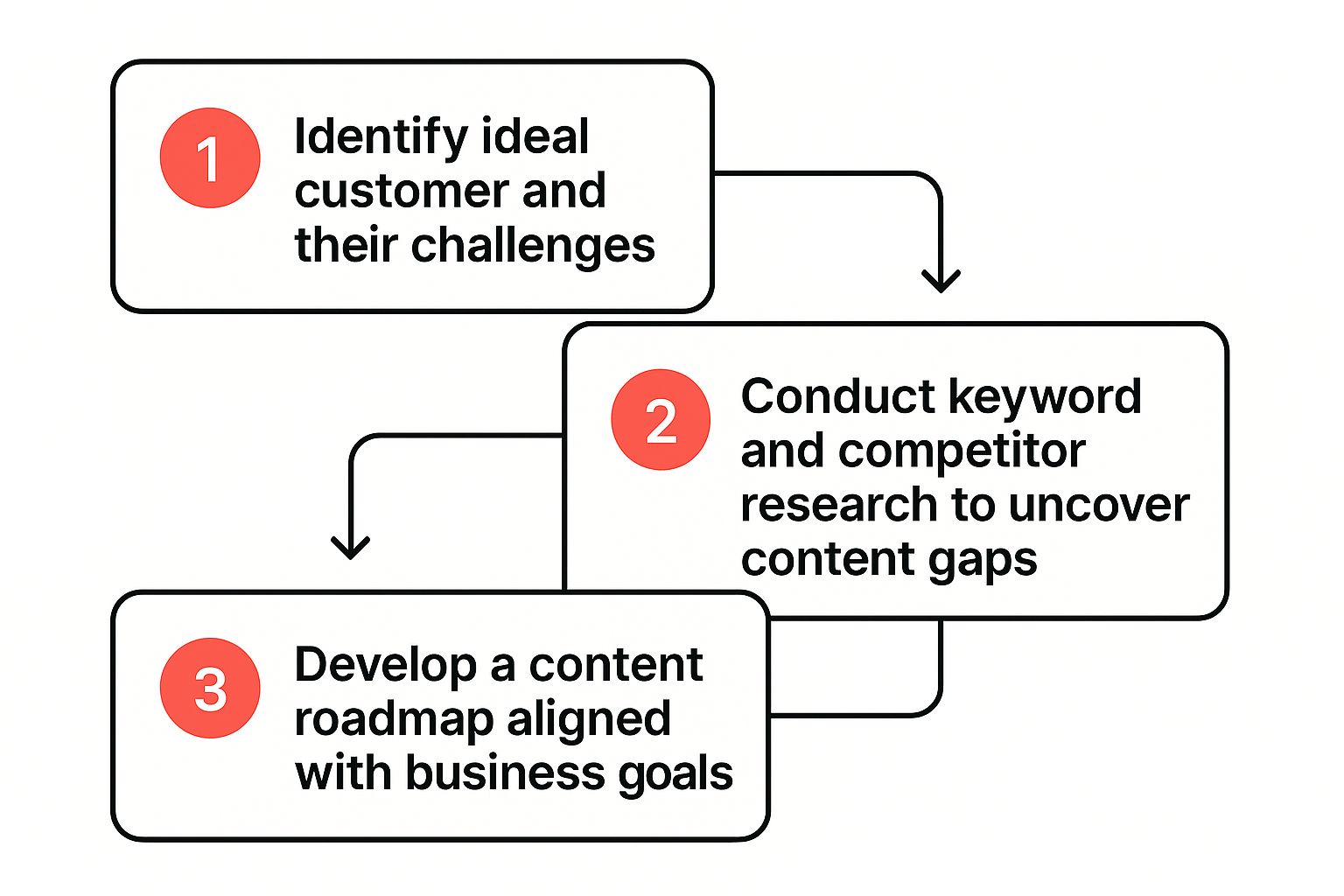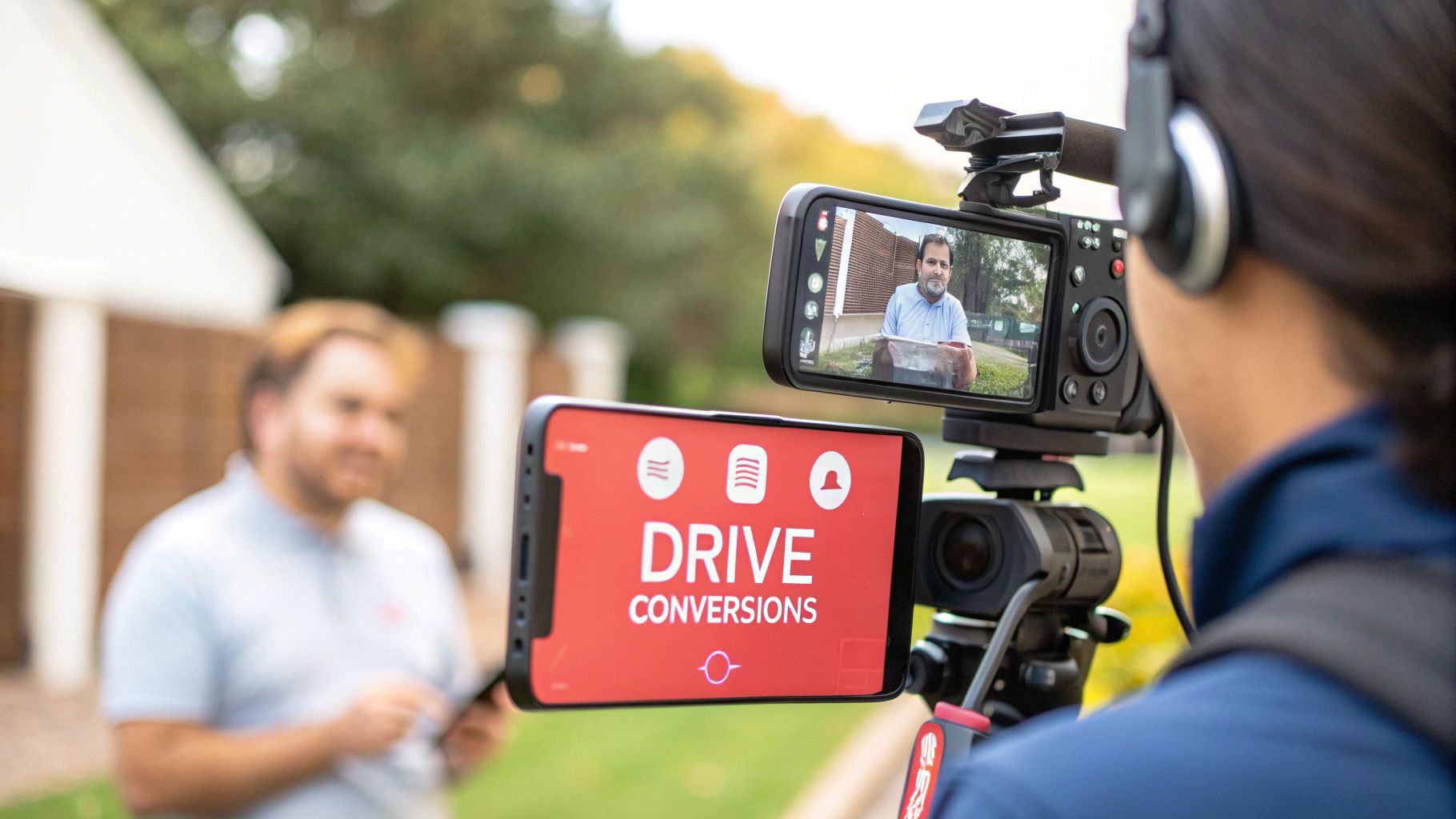Content Marketing for Startups: The Ultimate Growth Guide
For a startup, content marketing is not just another item on a long to-do list; it is the most powerful and cost-effective way to build a brand from the ground up. It is all about creating genuinely useful stuff—like blog posts, videos or case studies—that your target audience actually wants to find. This approach helps you attract and educate potential customers, building trust and generating leads without needing a massive advertising budget.
For any new business, this strategy is not just an option. It is a critical lever for sustainable growth.
Why Content Is a Startup’s Secret Weapon

With a tight budget and a huge mountain to climb, most founders get stuck on where to even begin with marketing. Paid ads offer a quick hit of visibility but it often feels like you are just renting an audience. The moment you stop paying, the traffic vanishes.
Content marketing is different. It is about building an asset that actually grows in value over time.
Think of it as creating a marketing engine that builds its own momentum. Every single blog post, case study or video you publish acts like a digital salesperson, working around the clock to bring in potential customers. It is an approach that lets you compete with much larger, more established players by focusing on your expertise, not your bank balance.
Building Trust Before the Sale
Startups always face the same big hurdle: a lack of trust. Your potential customers have no idea who you are, what you stand for or if your solution really works. Content gives you the perfect platform to prove your expertise and build that crucial credibility long before you ever ask for a sale.
By consistently answering your audience's most pressing questions, you achieve two vital goals:
- You establish authority: You become the go-to source for reliable information in your niche.
- You build relationships: You provide real value, which fosters a genuine sense of trust and connection.
For a startup, trust is your most valuable currency. Content marketing is the most direct way to earn it by showing, not just telling, your audience that you understand their problems and have the expertise to solve them.
A Cost-Effective Path to Growth
This strategy is especially powerful for new businesses that need to make every pound count. In the UK, a whopping 72% of businesses already use content marketing, with many marketers considering it a core business activity. That tells you everything you need to know about its widespread adoption. This trend is particularly relevant for startups that have to rely on smart, cost-effective methods to reach their audience and drive growth.
Ultimately, content marketing allows you to create a sustainable pipeline of organic traffic and leads. It takes patience to get going, for sure. But the long-term return on investment often blows temporary ad campaigns out of the water, creating a solid foundation your business can grow on.
For a deeper dive, explore our guide on the role of content marketing in building brand authority.
Building Your Startup Content Strategy
Great content marketing starts with listening, not writing. It is the difference between guessing what might work and building a deliberate plan where every article, video and social post has a clear purpose. Before you even think about a headline, you need to get inside the heads of the people you want to reach. What are they struggling with? Where do they hang out online?
This is the foundational work that turns random acts of content into a predictable growth engine. The startups that win with content are not just chasing the latest trends; they are obsessed with creating genuine value for a very specific group of people.
The process is simpler than it sounds. It is about moving from audience to action.

As you can see, the journey begins with your ideal customer. From there, it flows through smart research and solidifies into a roadmap that ties your content directly to your startup's biggest goals.
Get Clear on Your Ideal Customer and Their Problems
First things first: you need to get laser-focused. If you try to talk to everyone, you will end up connecting with no one. The starting point is to build out a detailed buyer persona —a snapshot of your perfect customer, pieced together from market research and any real data you have.
But do not stop at the basics. Go deeper than just demographics. What are their biggest professional headaches? What questions are they Googling late at night? What does success look like for them? For instance, a startup selling project management software might focus on "Alex, the overwhelmed agency owner." Alex’s core problem is not a lack of tools; it is the constant stress of juggling client projects and blowing deadlines.
Your customer's problems are the lifeblood of your content strategy. Every piece you create should feel like the answer to a question they are already asking or the solution to a problem they are desperate to solve.
Once you know who Alex is, you can map out their journey. Think about the stages they go through—from vaguely realising things are chaotic to actively searching for a better way to work. This understanding will dictate what kind of content you create and when. If you are looking to turn scattered efforts into a reliable system, we break this down further in our guide on building a marketing engine that delivers consistently.
Dive Into Keyword and Competitor Research
Now that you have a crystal-clear picture of your customer, it is time to figure out how they look for solutions online. This is where keyword and competitor research comes in but it is not just about chasing high-volume search terms.
The real goal is to uncover user intent . What is someone really trying to achieve when they search for "best tools for remote teams"? Are they looking for a quick list, a deep-dive comparison or free templates? The intent behind the search tells you what kind of content to create.
Use SEO tools to see what your competitors are ranking for. Pay close attention to the "content gaps"—these are the valuable topics they have either ignored or only covered superficially. These gaps are your golden opportunities. If a competitor has a basic listicle, you can win by creating a comprehensive, practical guide packed with real-world examples and expert insights.
To get started without reinventing the wheel, a solid content marketing strategy template can give you a framework for organising your ideas into a plan you can actually execute.
Choosing Content Formats That Actually Convert

With a strategy in place, the next big question is how to actually deliver your message. It is a classic startup dilemma: you have brilliant ideas but limited resources. Not all content formats are created equal and you simply cannot afford to spread yourself thin trying to master every single one.
The real key is to focus. Pick one or two formats that genuinely play to your team's strengths and, just as importantly, match how your audience actually consumes content. A quick, authentic video can forge a human connection far better than a stuffy white paper ever could. Meanwhile, a sharp infographic can make complex data a breeze to understand and share.
The Rise of Short-Form Video
Let’s be honest, video is no longer a "nice-to-have" for startups. It has become an essential tool for cutting through the noise. Short-form video, popularised by giants like TikTok and Instagram Reels, is dominating social feeds for one simple reason: it is incredibly engaging and easy to digest.
For a startup, this format is a gift. It does not demand a Hollywood budget. In fact, authentic, behind-the-scenes clips, quick tutorials or founder Q&As filmed on a smartphone often perform better because they feel genuine and relatable.
The data backs this up. In the UK market, an overwhelming 83% of consumers want to see more video from brands, making it a direct line to your audience. This UK content marketing statistics report offers more on that. By focusing on video, you are tapping straight into existing user habits. If you need more guidance, you can explore our article on how to maximise the ROI of video content.
Becoming a B2B Lead Generation Machine on LinkedIn
If your startup is targeting other businesses, LinkedIn needs to be the centre of your content universe. Think of it less as a professional networking site and more as a powerful B2B engine where decision-makers are actively looking for industry insights.
But do not just post links to your latest blog. The most effective LinkedIn content delivers value right there in the feed. This means creating formats that spark engagement and position you and your team as the experts.
Here are a few powerful LinkedIn formats to get you started:
- Text-only posts: Share a personal story, a strong opinion or a practical tip. These posts often get incredible engagement because they are quick to read and feel authentic.
- Simple infographics or carousels: Break down a complex idea or share key data points in a visually appealing, swipeable format. They work wonders for stopping the scroll.
- Polls: Ask your audience a relevant question. It is a brilliant way to spark conversation and gain real insight into their challenges.
LinkedIn is not about broadcasting; it is about starting conversations. The goal is to become a trusted voice by consistently sharing valuable, relevant insights directly on the platform where your ideal customers are already spending their time.
By choosing formats that play to each platform's strengths and align with what your audience wants, you can make a huge impact without a massive budget. This focused approach ensures every piece of content works harder for your startup.
Creating and Distributing Content Like a Pro

A brilliant idea is worthless without solid execution. Once you have nailed down your strategy and chosen your formats, the real work begins. Creating high-quality content can feel like a mountain to climb, especially when you are a team of one. But with a simple workflow and the right tools, you can produce professional content consistently without a huge budget.
The goal is not perfection; it is about providing genuine value that solves your audience’s problems. Whether it is a blog post, a short video or a simple infographic, focus on being clear, helpful and authentic. This is how you build trust and authority from day one.
Building Your Creation Workflow
To avoid that feeling of being completely overwhelmed, you need a repeatable process for every piece of content you create. This gives your creativity some much-needed structure and ensures you do not miss crucial steps, particularly when it comes to search engine optimisation (SEO).
Here is a simple workflow you can steal:
- Outline First: Before you write a single word, create a detailed outline based on your keyword research. Structure your content with headings (H2s, H3s) that target your primary keyword and all the related questions people are asking.
- Draft with Focus: Get that first draft down without worrying too much about grammar or style. The only goal here is to get your ideas onto the page and answer the user's query comprehensively. Just write.
- Edit and Optimise: Now it is time to polish. Refine your writing for clarity, add your main keyword to the title and introduction and sprinkle related terms naturally throughout the text. Free tools like Grammarly are great for a final proofread.
- Add Visuals: Nobody wants to read a wall of text. Break it up with relevant images, screenshots or simple graphics. Tools like Canva have free templates that make it ridiculously easy to create professional-looking visuals, even with zero design experience.
This structured approach turns a huge task into a series of small, manageable steps. It is the key to maintaining quality and consistency, which are vital for building any successful content programme.
A common mistake startups make is trying to create everything from scratch every single time. Instead, focus on creating templates and repeatable workflows. This efficiency is your competitive advantage.
Making Distribution Your Priority
Hitting 'publish' is not the finish line. It is the halfway point. Even the most incredible piece of content is useless if no one ever sees it. Distribution is the active, deliberate process of getting your work in front of your target audience.
Too many startups neglect promotion, thinking that great content will magically find its own audience. The reality? You need to give it a significant push, especially in the early days when you have little to no organic reach. You should dedicate as much time to distributing your content as you do to creating it.
A Simple Distribution Checklist
Do not try to be everywhere at once. It is a recipe for burnout. Focus your energy on the channels where your ideal customers are already spending their time.
Here is a straightforward checklist to run through for every piece of content you publish:
- Share on Your Core Social Channels: Post your content on the one or two social media platforms you have decided to prioritise. Do not just drop a link and run; write a compelling caption that explains why the content is valuable and encourages a bit of discussion.
- Send it to Your Email List: Your email list is one of your most valuable assets, period. Send a newsletter featuring your new content, explaining the key takeaways and why your subscribers should care enough to click.
- Engage in Online Communities: Find relevant subreddits, LinkedIn Groups or Slack communities where your audience hangs out. Share your content in a helpful, non-spammy way by adding context and answering questions. Always, always check the community rules first.
- Repurpose for Different Platforms: Do not let your hard work go to waste. Turn a blog post into a Twitter thread, a key statistic into a sharp LinkedIn graphic or a video tutorial into a series of Instagram Reels. This maximises the value of your initial effort and reaches people in the format they prefer.
Using AI to Amplify Your Content Efforts
As a startup, time is your most precious asset. Artificial intelligence might sound like a futuristic, complex beast but it is now a practical tool that can act as your content marketing co-pilot. It is about creating better content, much faster, without burning out your small team.
Think of AI not as a replacement for human creativity but as a seriously powerful assistant. It is brilliant at handling the repetitive, time-sucking tasks that clog up the creative process. This frees you up to focus on what actually matters: strategy, storytelling and building a real connection with your audience.
Where AI Truly Shines for Startups
Instead of getting lost in the hype, focus on the practical applications that will give you an immediate return on your efforts. AI is exceptionally good at speeding up the initial, often painful, stages of content development.
Here are a few ways you can slot it into your workflow right now:
- Brainstorming Topic Clusters: Feed an AI tool a core theme like "B2B lead generation." It can instantly spit out dozens of related sub-topics and long-tail keywords, helping you map out entire content hubs without the guesswork.
- Drafting Outlines: Go from a blank page to a structured article in minutes. AI can create logical outlines with clear headings and subheadings, giving you a solid framework to build on. No more staring at a blinking cursor.
- Summarising Dense Research: Found a monster industry report? An AI can distil the key findings and stats into a concise summary, saving you hours of reading and analysis.
The real power of AI in content marketing for startups is not about automating everything. It is about augmenting your own skills, allowing you to produce a higher volume of quality content with the limited resources you have.
Integrating AI Tools into Your Workflow
The UK's marketing scene is catching on fast. By 2025 , a massive 51% of UK retail leaders believe AI will be crucial for unlocking business growth. This is not just a trend; it is a massive opportunity for startups to gain a competitive edge.
When you start looking at AI content tools, it pays to compare a few platforms. Exploring options like AI writing assistants like Jasper can help you find the right fit for your specific needs and budget. The key is to find something that slots into your existing process, not something that disrupts it. The goal is to maintain consistency and get a much bigger return from the content you are already creating.
Measuring the Metrics That Drive Growth
Creating great content is only half the battle. The real question is, how do you know if it is actually working?
This is where measurement comes in but it is easy to get lost in vanity metrics like page views and social media likes. These numbers might give you a short-term buzz but they do not signal real business impact. They do not pay the bills.
Effective content marketing for a startup is all about tracking the numbers that translate directly into growth. You need to connect every blog post, every download and every video to a tangible business objective. This is not about building complex dashboards; it is about relentlessly tracking a few key indicators that matter.
Key Performance Indicators to Track
To get a true picture of your content’s performance, you need to focus on metrics that show genuine progress. These KPIs help you understand what is resonating with your audience and, more importantly, what is driving them to act.
From day one, these are the core metrics you should be watching:
- Organic Traffic Growth: Are more people finding you through search engines? More specifically, you want to track the increase in traffic from non-branded keywords . This is a clear sign that your content is attracting a new audience that does not know your brand yet.
- Lead Conversion Rates: Of the people who read your content, how many take the next step? This could be signing up for a newsletter, requesting a demo or starting a free trial. For a startup, this is arguably the single most important metric.
- Keyword Ranking Improvements: Are you climbing the search engine results pages for your target commercial terms? An upward trend here is a powerful leading indicator of future traffic and, ultimately, lead growth.
The goal is not just to attract an audience; it is to attract the right audience. Focusing on conversions and keyword rankings for commercial terms ensures your content is not only seen but is also driving qualified leads into your pipeline.
A Simple Framework for Monthly Audits
To stay on track, set up a simple monthly content audit. This does not need to be some exhaustive, all-day process. Just block out a couple of hours each month to dive into your analytics and answer a few critical questions about what is performing and what is not.
This regular check-in helps you spot what is working so you can double down on the topics, formats and channels that deliver the best results. It is a straightforward cycle: create, measure, learn and refine. This iterative approach is the secret to building a content engine that delivers predictable, sustainable growth over the long haul.
At Superhub , we specialise in creating data-driven content strategies that turn startups into industry leaders. If you are ready to build a marketing engine that delivers real results, learn how our expertise can help you grow at https://www.superhub.biz.





